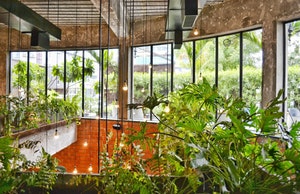 NATIONAL REPORT—When a guest walks into a hotel, they’re often tired from a long day of travel. They want a warm, comfortable room where they can relax and unwind, an accommodating space where they’re free to kick off their shoes. In this regard, the standard hotel is satisfactory.
NATIONAL REPORT—When a guest walks into a hotel, they’re often tired from a long day of travel. They want a warm, comfortable room where they can relax and unwind, an accommodating space where they’re free to kick off their shoes. In this regard, the standard hotel is satisfactory.
Of course, professionals in the hospitality industry don’t want to provide just a “satisfactory” experience for their customers. To separate themselves from their competition, they need to go beyond what others have done in the past. They must adapt their practices to remain relevant.
Green design represents an opportunity. With the application of these principles, hospitality professionals can enhance the guest experience and make every stay as memorable as possible. More than that, these changes don’t require a substantial sum of money to make.
What do the changes look like, and what effect do they have on customers? How does green design take an average hotel and make it something more? Here are the many benefits of green design within the built environment.
The Physical Benefits
The Environmental Protection Agency says people spend about 90 percent of their time inside, increasing their exposure to toxins. Several factors contribute to the problem, such as inadequate ventilation and off-gassing from carpeting and furniture. Despite the prevalence of the issue, it’s possible to protect against it.
One of the most effective measures for improving indoor air quality is the use of common houseplants. Research from NASA has confirmed the value of plants, stating they’re “one of the most promising means of alleviating the sick building syndrome associated with many new, energy-efficient buildings.”
The effects of natural light are essential to note as well. With skylights and different bulbs, hospitality professionals can improve the comfort of their guests and make the interior of their hotel feel more natural. As an example, blue-enriched lighting during the daytime often results in better sleep at night.
The Mental Benefits
When hotels choose to integrate the principles of green design—such as plant life and natural light—they enjoy more than just an improvement in their guests’ physical health. They also see a significant change in their customers’ mental well-being, with reduced stress levels and faster rates of psychological restoration.
Something as simple as a depiction of a nature scene can have a positive influence on a guest’s perception of a space. Whether it’s a wallcovering with a pattern of birch trees or a painting of a landscape, green design can increase guest satisfaction at a comparatively low cost, next to other renovations.
Even so, hospitality professionals who intend to remodel an area of their building, like their lobby, should give thought to the design essentials that make the space work. When they acknowledge these requirements, they can find ways to incorporate them into their planned changes.
The Social Benefits
Beyond the physical and mental effects of green design, it also has implications for a hotel’s reputation. Today’s consumers are concerned with sustainability and eco-conscious lifestyle choices, and they seek brands that support their values. Green design reflects a company’s willingness to improve on outdated practices.
In addition to the changes above, green design also has a focus on sustainability. It enhances the guest experience, of course, but it also minimizes the impact of a commercial building on the environment through energy efficiency and eco-friendly materials. These aspects are attractive to prospective guests.
A 2015 Nielsen study found that 66 percent of people say they’re willing to pay more for services that come from companies committed to making a positive social and environmental impact. As the upcoming generation ages, the social benefits of green-focused initiatives should only amplify over time.
Embracing Green Design
Professionals in the hospitality industry can provide more than just a satisfactory experience for their guests. When they evaluate their interior design and search for areas where they can implement small, eco-conscious changes, they’ll see a marked improvement in the perception of their hotel.
Whether they invest in indoor greenery, a nature-related wallcovering or a more involved renovation, hospitality professionals can feel secure in their choice. With that in mind, they should take the next step and review their options, planning their next project as soon as possible. It’s never too early to plan for the future.
Holly Welles is a real estate writer with an interest in sustainability’s impact on the industry. Recently, she’s covered green architecture for online publications including Modlar and CADdetails. More of her work can be found via Twitter or on her personal real estate blog, The Estate Update.






